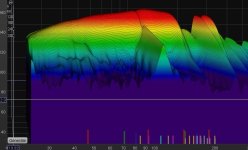Is it the tapered shape that’s preventing the ringing/slow decay ?
(The parallel straight pipe drawing goes with the measurement that has the big issue at 108 hz, its actually 80 cm and 240cm)
(The parallel straight pipe drawing goes with the measurement that has the big issue at 108 hz, its actually 80 cm and 240cm)
Attachments
The two measurements show very different frequency responses, one with a rising response from low frequency to high, the other with a low frequency peak and upper response falling at approximately the inverse of the first response.

Attributing the decay at a single frequency (108Hz) to the taper alone in two completely different designs seems a stretch.
Attributing the decay at a single frequency (108Hz) to the taper alone in two completely different designs seems a stretch.
The ringing(108hz high ‘Q’?) measurement is in the parallel pipe(drawn) . It’s 240cm and 80cm (like a paraflex)
The other measurement is the folded tapered thing.
(Sorry the pics got out of order)
Do the straight and parallel pipes inherently want to do that?
The other measurement is the folded tapered thing.
(Sorry the pics got out of order)
Do the straight and parallel pipes inherently want to do that?
No idea how those two lengths are like or unlike a paraflex (Paragon + FlexTech?).It’s 240cm and 80cm (like a paraflex)
The difference in frequency response and design of the folded reverse tapered thing and the parallel pipe make it impossible to attribute inherent properties to a single specific design aspect.Do the straight and parallel pipes inherently want to do that?
That said, certain combinations of wavelength and length of a closed end pipe will result in a standing wave or resonance.
https://calculator.academy/closed-pipe-resonance-calculator/
Damping out unwanted resonances without removing the desired resonances requires finding their origin, which likely would be in the 80cm stub.
Since that portion also contains two drivers, the pipe is not "straight or parallel" in that section 😉 .
Patrick Sander (Ballfred 1) posted some graphs of a C2E- GF ("Golden Formula"..) with 50-80% damping material in the stubs to avoid a ringing tone at 97Hz.
Hi all together. 😉 I am one of the Co-Designers of the C2E-GF and i did the optimizations and testings for the latest update V42.11 on the Facebook homepage.
I want to share some graphs with you, just for some "ah, okay" effects.
But before that, some notes:
Hearing is the essential thing when it comes to Paraflex Designs.
When i started building subwoofers i started with Tapped-Horns. MTH30, MTH46VS (updated to big Tham18) and that was my way to go.
Then one day i saw that C2E classic cab with centered driver and i was done - i needed those!
I contacted and joined the group, told...
I want to share some graphs with you, just for some "ah, okay" effects.
But before that, some notes:
Hearing is the essential thing when it comes to Paraflex Designs.
When i started building subwoofers i started with Tapped-Horns. MTH30, MTH46VS (updated to big Tham18) and that was my way to go.
Then one day i saw that C2E classic cab with centered driver and i was done - i needed those!
I contacted and joined the group, told...
It probably has 90cm stubs..
Art


